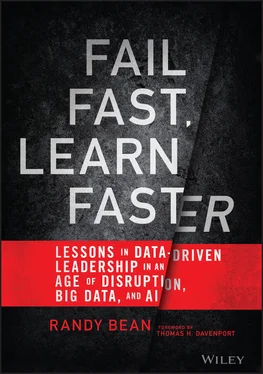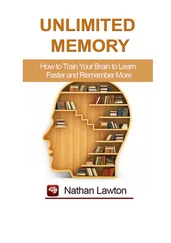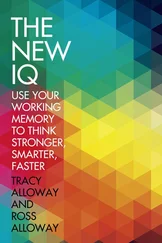The lessons of this book are delivered in clear language and without technical jargon. I've worked with Bean for almost 20 years, and I've read a lot of his writing. He prides himself on his ability to communicate about technical subjects to people with no technical backgrounds. If you are someone in a business role who has heard about such topics as big data, artificial intelligence, and digitization, and you want to know what all the fuss is about without getting lost in technical detail, you have come to the right place. Bean has made a successful career out of telling senior business executives what technology and data mean to them in clear terms. Many of them have turned to him in part because they can't understand what their own technology people are telling them.
Part of that communications ability is based on effective storytelling, and Bean has included many story-based examples in the book. His consulting firm works with many of the executives and companies profiled in these pages, so he has the ability to provide context and broad perspective on the issues addressed in each situation. They are the classic recurring themes in technology management in business: how to align technology efforts with business strategy, how business leaders and technology managers can collaborate effectively, how large, established firms can compete with disruptive startups, and so forth.
That last question about disruptive startups is, I believe, at the heart of the book. You will find occasional mentions of Facebook, Amazon, and Google in this volume, but the bulk of the examples are about large, well-established businesses that are trying to transform themselves. They know that a really successful startup could eat their lunch if they don't protect it. Jamie Dimon, CEO of JPMorgan Chase, was asked whether a hypothetical “Bank of Amazon” or “Bank of Google” would seriously threaten his bank's success in the industry. Dimon said, “Of course …We have very aggressive players trying to compete in our business. And we'll always compete very aggressively.” That is the challenge of the age for many of the firms described in this book. They need to compete effectively with digitally native firms if they are going to survive over the long run. They – and you – will find plenty of examples of firms that have thus far used modern competitive weapons to keep the wolf away from the door.
One of my favorite stories in the book features a veteran data and analytics leader, Ash Gupta, at a veteran firm, American Express. Gupta rose to the position of president, Global Credit Risk and Information Management, at American Express over the course of a 41-year tenure. To me his story illustrates several key points about the introduction and management of information technology in large organizations, and how much one individual can do to improve a big company over time. Gupta's long career at American Express reminds us that the game of building technology, data, and analytics capabilities has a long season that is heavily shaped by individual leaders. For four decades Gupta continually innovated at the company, eventually embedding data and analytics at the core of the enterprise. Randy Bean's writings about Gupta embody many lessons that are present throughout the book, but I was particularly reminded of two.
One is to take a long-term perspective. We often get caught up in breathless news about the latest technology and the fastest-growing vendors. But the creation of a data-driven company like American Express happens over decades. Bean takes this long-term perspective throughout the book, which makes it unusual among books about information technology.
The other key lesson is the importance of talent acquisition in creating this type of continuous renewal. Gupta brought in many of the best and brightest data and analytical minds available throughout the world. I regularly meet very smart people throughout the financial services industry who tell me with pride, “Ash Gupta recruited me to Amex.” That background tells me that they will be not only smart and well-educated, but oriented to the business and able to fit into a collaborative culture.
Gupta was present at a meeting that Bean and his company NewVantage Partners convened in New York in February 2020, which was my last trip before the COVID-19 pandemic curtailed my travel for more than a year. One topic we discussed was educating managers about the importance and value of data. Gupta's comments were a reminder of the very human approach needed to succeed with this topic. He said that his approach to educating leaders was to embark on a set of one-on-one learning sessions with the company's most senior executives. He knew that was the best way to make the lessons personal, and he could draw upon a deep well of trust he had built with these leaders over the decades.
Don't get me wrong; this book isn't just a collection of heartwarming stories about wise and capable people like Ash Gupta. There is plenty of solid and easily understood advice about data and technology management, including topics like data lakes, DataOps, data lineage, real world evidence, machine learning–based image recognition, and many other topics. All are made both more interesting and more relevant with up-to-the-minute examples from leading companies. But the book is a reminder that the world of data and technology management in companies is just as much about relationships among people as it is relationships among data. Data requires accuracy and integrity, but so do the people who manage it. We need to trust our data, and we need to trust the human beings who help to create, capture, store, and analyze it. Data informs humans, and humans inform data. Read this book to find many examples and lessons about humans finding ways to make data support better ways of doing business.
Thomas H. Davenport
Distinguished Professor, Babson College
Visiting Professor, Oxford University
Fellow, MIT Initiative on the Digital Economy
“Perfect is the enemy of good .”
—Voltaire
I wrote this book during the second winter of COVID-19, 2020–2021. Travel was not an option. I had the time.
I had been writing articles and columns for many years, published in the Wall Street Journal , Forbes , MIT Sloan Management Review , and Harvard Business Review . People asked if I was ever going to write a book. I told them only if it was the next Moby-Dick , or a social comedy or observation of life in the seaside village that I moved to part-time a dozen years ago. Perhaps an updated Peyton Place . My neighbors can breathe a sigh of relief. No kiss and tell this time around.
They say write about what you know. I had never been a Pacific whaler, so I could not rewrite Moby-Dick . However, I had lived and worked for four decades during one of the periods of greatest technological transformation in modern times – the Information Age.
I began my career working in a big bank in Boston (an old bank, too – the motto was “Founded in 1784”). I had no technical skills or business background but was trained by the bank at their expense to be a computer programmer (in Cobol). To my surprise, and maybe the bank's as well, they thought I was good at it and so asked me to keep it up. I grew restless though and moved to the business side of the bank (strategic planning). I was curious about how businesses operate and how decisions were made. Working as a computer programmer, I wrote computer programs that moved data around. I asked what the organization did with all this data, and whether it could be analyzed to arrive at better decisions. I was met with blank stares.
After a decade I joined a company that specialized in data (database marketing) and helping very big companies use that data to better understand their customers – get, keep, grow. One of my customers was Steve Ballmer at Microsoft – even the tech gods believe that to stay on top you need to relentlessly probe the data. It was the Internet era. I went on to become an executive with two Internet startups, and a founding executive (prefunding) of the second one – our lead investors included Kleiner Perkins. It was a whirlwind.
Читать дальше












